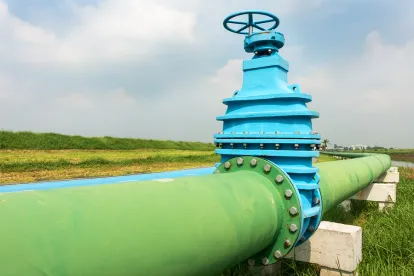PHMSA proposes new rule to reduce regulatory burden. PHMSA requests comments on proposed Farm Tap FAQs. Status of PHMSA Rulemakings. PHMSA issues guidance to state pipeline safety program managers regarding enforcement of plastic pipeline regulations. District court dismisses complaint against PHMSA regarding inspection of pipelines located on federal lands. API releases two standards addressing natural gas gathering pipelines. Pipeline Association for Public Awareness issues 2020 Excavation Safety Guide. Texas Railroad Commission reminds operators to include abandoned pipelines in digital mapping shapefiles.
PHMSA Proposes New Rule to Reduce Regulatory Burden
On April 16, the Pipeline and Hazardous Materials Safety Administration (PHMSA) issued a notice of proposed rulemaking (NPRM) proposing to amend the agency’s enforcement and regulatory procedures (Part 190), regulations governing facility response plans for oil pipelines (Part 194) and safety regulations applicable to hazardous liquid pipelines (Part 195). PHMSA states that the proposal is intended to reduce regulatory burden. Except for proposed changes to Part 190 which affect all PHMSA-regulated facilities, the NPRM affects regulations applicable to oil and hazardous liquid pipelines. At a later date, PHMSA expects to issue a second NPRM proposing amendments to regulations affecting gas pipelines.
Comments on the NPRM are due on June 15, 2020.
Proposed Changes to Part 190. Part 190 of PHMSA’s regulations contain the agency’s procedures governing enforcement and the adoption of rules. The NPRM proposes the following amendments to Part 190.
Electronically submitted documents. The NPRM would clarify that an operator may submit records in an electronic format, as long as PHMSA has the ability to download and print a copy of each record free of redactions, watermarks, and other alterations. An electronic document must be submitted in its original format unless an alternative format is approved, and PHMSA must have the same functionality within the document that is available to the operator.
Submission of confidential commercial information. In proceedings where PHMSA is not required to place material submitted by an operator into a public docket (i.e., investigations or inspections), PHMSA proposes to allow an operator to submit only a non-redacted version of a document that the operator seeks to keep confidential to protect commercially sensitive information, instead of both redacted and non-redacted versions. In proceedings where PHMSA is required to place documents into a public docket (i.e., rulemakings or petitions for special permits), PHMSA would continue to require that an operator submit both redacted and non-redacted versions of confidential documents. PHMSA states that this proposal would alleviate an operator’s burden of having to create redacted and non-redacted copies of documents that are submitted in non-public proceedings. In addition, PHMSA is proposing to require that operators provide a specific explanation of why the information is confidential commercial information.
Proposed Changes to Part 194. The NPRM would make a number of changes to Part 194 which requires that an operator of an onshore oil pipeline submit a facility response plan (FRP) for a worst-case discharge if a release could cause substantial environmental harm to navigable waters of the U.S. or adjoining shorelines. FRPs are required under the Oil Pollution Act of 1990.
Applicability. The NPRM clarifies that Part 194 applies to an onshore oil pipeline facility if a discharge from the pipeline could affect navigable waters of the U.S. or adjoining shorelines within 12 hours of the release, and does not apply to an onshore pipeline facility if a discharge could not affect navigable waters within 12 hours of a release. In addition, the NPRM clarifies that Part 194 does not apply to onshore oil pipelines that are 65/8 inches or less in diameter and longer than 10 miles in length, or that are larger than 65/8 inches in diameter and 10 miles or less in length if these pipelines could not affect navigable waters or adjoining shorelines within 4 hours of a discharge.
Elimination of references to “significant and substantial harm” and “substantial harm.” Stating that no functional difference exists between the requirements for facilities that could cause “significant and substantial harm” or “substantial harm,” PHMSA proposes to remove references to these terms. PHMSA would review all FRPs for compliance and issue letters of approval for acceptable plans. The NPRM also would clarify that an operator is required to resubmit FRPs within 5 years of the date of last approval.
Calculating worst-case discharge. When calculating the worst-case discharge, the NPRM would permit an operator to use spill models and would remove the requirement that the calculation include largest historical discharge volumes.
Harmonization of response times with USCG guidelines. In response to a Department of Transportation (DOT) audit which found that Part 194 does not adequately specify the resources needed to respond to a spill, the NPRM is proposing to harmonize Part 194 with the U.S. Coast Guard’s (USCG) “Guidelines for Determining and Evaluating Required Response Resources for Facility Response Plans.” The NPRM also proposes additional guidance for responding to worst-case discharges occurring in high-volume areas and to include more inland waterways than contained in the USCG Guidelines.
Other proposed changes. The NPRM proposes a number of other amendments to FRP requirements. Among them, the NPRM would (1) require procedures for providing Safety Data Sheets to emergency responders and the Federal On-Scene Coordinator within 6 hours of a spill; (2) clarify that immediate notification of spills also must be made to the National Response Center; (3) allow an operator to submit an FRP that was prepared to meet a State requirement if the operator also submits a DOT-specific appendix addressing Part 194 requirements not contained in the State plan; (4) clarify that maps, including current submissions to the National Pipeline Mapping System, are an acceptable means of describing the location of the response zone and pipeline facilities; (5) harmonize oil pipeline response planning requirements with those of the USCG; and (6) require submission of an FRP for a new pipeline when it becomes operational, not while it is under construction.
Definitions. PHMSA proposes to add, remove and modify several definitions, including the definition of “onshore pipeline facilities” to clarify that Part 194 applies to any oil pipeline landward of the coast line, regardless of whether the pipeline is considered an onshore facility under the Clean Water Act.
Incorporation by reference. The NPRM would create a new section listing standards and documents of the American Petroleum Institute (API), the National Fire Protection Association (NFPA), and the USCG that are incorporated by reference. PHMSA also proposes to incorporate the Guidelines for the U.S. Coast Guard Oil Spill Removal Organization Classification Program.
Proposed Changes to Part 195. Part 195 of PHMSA’s regulations sets forth the safety regulations applicable to hazardous liquid pipeline facilities. The NPRM proposes the following amendments.
Definition of “accident.” The NPRM proposes to amend the definition of “accident” by increasing the monetary threshold for property damage from $50,000 to $118,000. PHMSA also intends to adjust the threshold on a regular basis to account for inflation and describes the formula that would be utilized.
Remote monitoring of external corrosion. PHMSA is proposing to clarify § 195.373(c) to allow an operator to electrically check rectifier stations remotely. Such checks must contain amperage and voltage measures. However, when testing a cathodically protected pipeline, which is required each calendar year not exceed 15 months, an operator must perform a physical inspection.
Appendix C Guidance for Implementation of an Integrity Management Program. PHMSA proposes to revise the guidance contained in Part 195’s Appendix C with respect to considering spills in fields and by moving certain details for considering physical pipeline supports, exceedances of maximum operating pressure, and natural force damage caused by earth movement or seismicity out of PHMSA’s guidance for identifying segments that could affect HCAs and into the guidance for identifying threats.
PHMSA Requests Comments on Proposed Farm Tap FAQs
On April 20, PHMSA announced a Request for Comments on proposed frequently asked questions (FAQs) regarding farm taps, which PHMSA describes as “individual service lines directly connected to production, gathering, or transmission pipelines.” PHMSA states that the proposed FAQs reflect how the agency currently applies its regulations to the specific implementation scenarios presented. Comments on the proposed Farm Tap FAQs are due June 19, 2020
Topics addressed in the proposed FAQs. Topics addressed in the FAQs include how to determine if a farm tap is regulated; reporting requirements for distribution services from an unregulated source pipeline; applicability of operation and maintenance requirements; regulatory definitions; applicability of certain requirements to existing facilities; and testing requirements.
Among other things, the proposed FAQs would clarify the definition of a farm tap. Specifically, the proposed FAQs state that a farm tap begins at the first point where the line can be isolated from the upstream source pipeline, such as the inlet to a valve or regulator. The line downstream of this “first isolation point” would either be a service line (i.e. distribution) or customer-owned piping. If no isolation point exists, then the pipe downstream from the source pipeline has the same classification as the source pipeline until the connection with customer-owned piping. In such cases, there would be no service line. The FAQ’s proposed identification of the beginning of a farm tap would provide important regulatory clarity.
PHMSA states that, when finalized, the FAQs will supersede FAQ C.3.7 in the Distribution Integrity Management (DIMP) FAQs. In addition, PHMSA is considering revising requirements for maintaining pressure-regulating, limiting, and overpressure protection devices on farm taps.
Background. In the Request for Comments, PHMSA explains that in January 2017, PHMSA issued a final rule adopting § 192.740 which requires that operators of gas pipeline inspect and perform tests on pressure regulating or limiting devices, relief devices (except rupture discs), automatic shut off devices and associated equipment that are located on “any service line directly connected to a production, gathering, or transmission pipeline that is not operated as part of a distribution system.” These inspections are required once every 3 calendar years, not to exceed 39 months. The final rule also adopted § 192.1003(b) exempting from DIMP individual service lines directly connected to transmission, gathering, and production pipelines.
In comments responding to DOT’s October 2, 2017 notice seeking input on existing rules that are good candidates for repeal, replacement, suspension or modification, industry stakeholders argued that PHMSA underestimated the cost of complying with § 192.740, and that operators could provide an equivalent level of safety by applying DIMP requirements in conjunction with other requirements, such as leak surveys. Stakeholders urged that sections 192.740 and 192.1003 be modified to give operators the flexibility to address the safety of farm taps under either regulation. In March 2019, PHMSA responded to those comments by issuing Announcement of Enforcement Discretion Regarding Farm Taps stating that the agency would not initiate enforcement against an operator that elects to manage the safety of farm taps under DIMP instead of § 192.740.
Status of PHMSA Rulemakings.
The chart below shows the status of PHMSA’s pending pipeline safety rulemakings as reflected in (1) DOT’s February Significant Rulemaking Report, (2) PHMSA’s status Chart of legislatively mandated actions, and (3) the Office of Management & Budget’s (OMB) Office of Information and Regulatory Affairs (OIRA) Fall 2019 Unified Agenda of Regulatory and Deregulatory Actions. The Unified Agenda appears in two principal parts, Current Agenda Agency Regulatory Entries for Active Actions and Current Long Term Actions. New Information is provided in Bold
Pending Final Rules
|
Proceeding |
DOT Estimated Publication |
OIRA Estimated Publication |
PHMSA’s Chart |
|
Safety of Gas Transmission Pipelines, Repair Criteria, Integrity Management Improvements, Cathodic Protection, Management of Change, and Other Related Amendments |
July 24, 2020 |
March 2020 |
September 9, 2021 |
|
Safety of Gas Gathering Pipelines |
July 24, 2020 |
June 2020 |
September 9, 2020 |
|
Underground Natural Gas Storage Facilities |
Published February 12, 2020 |
||
Pending Notices of Proposed Rulemakings
|
Proceeding |
DOT Estimated Publication |
OIRA Estimated Publication |
PHMSA’s Chart |
|
Amendments to LNG Facilities |
September 17, 2020 |
January 2020 |
March 17, 2020 |
|
Class Location Requirements |
June 22, 2020 |
April 2020 |
Not Listed |
|
Gas Pipeline Regulatory Reform |
January 29, 2020 |
January 2020 |
Not Listed |
|
Liquid Pipeline Regulatory Reform |
Published April 16, 2020 |
||
|
Periodic Standards Update |
Not Listed |
December 2019 |
Not Listed |
|
Repair Criteria for Hazardous Liquid Pipelines |
June 26, 2020 |
June 2020 |
Not Listed |
|
Valve Installation and Minimum Rupture Detection Standards |
Published February 6, 2020 |
||
Pending Advance Notices of Proposed Rulemakings
|
Proceeding |
DOT Estimated Publication |
OIRA Estimated Publication |
PHMSA’s Chart |
|
Coastal Ecological Unusually Sensitive Areas |
February 20, 2020 |
December 2019 |
May 8, 2020 |
Other PHMSA Updates
PHMSA issues guidance to State pipeline safety program managers regarding enforcement of plastic pipeline regulations. On March 12, PHMSA issued Enforcement Guidance to the State pipeline safety program managers addressing implementation of the 2018 Plastic Pipe Rule, which amended design, construction and maintenance requirements applicable to plastic piping.
Category 1 fittings on plastic to metallic connections of pipe 4 inches or more in diameter. On March 1, 2019, pursuant to a request by the American Gas Association (AGA), PHMSA extended until January 22, 2020 the deadline for using Category 1 fittings on plastic to metallic connections of pipe 4 inches or more in diameter. In the March 12, 2020 Enforcement Guidance, PHMSA states that it does not intend to enforce sections 192.281(e)(3) or 192.281(e)(4) for joints between metallic and plastic pipe with a nominal pipe size of 4 inches or more until August 31, 2020. PHMSA recommends that States also postpone enforcement of these requirements.
According to PHMSA, additional time is needed for manufacturers to complete testing for large diameter fittings and for operators to develop training, revise their procedures, and update their inventories.
Fusion Qualification: Alternative Procedures to ASTM F2620 for Polyethylene (PE). On August 23, 2019, AGA filed a petition for reconsideration of the Plastic Pipe Rule requesting that PHMSA amend sections 192.281 and 192.285 to permit alternatives to ASTM F2620 for qualifying joining procedures and joiners. AGA stated that, as drafted, these two sections preclude an operator from using previously qualified heat fusion procedures that have been developed by industry and published by the Plastic Pipe Institute. AGA also stated that, although the preamble to the Plastic Pipe Rule contemplated that other qualifying procedures would be acceptable if an operator could demonstrate they provide an equivalent or a superior level of safety compared to ASTM F2620, the regulation did not reflect that intent.
In the March 12 Enforcement Guidance, PHMSA states that it will enforce sections 192.281 and 192.285 consistent with the Plastic Pipe Rule preamble and recommends that States do the same. The Enforcement Guidance states that PHMSA will consider amending these sections to be consistent with the Plastic Pipe Rule preamble and that it is considering whether to incorporate by reference into Part 192 the 2019 version of ASTM F2620, which ties that procedure with procedures of the Plastic Pipe Institute identified in AGA’s petition.
Updates on Litigation
District court dismisses complaint against PHMSA regarding inspection of pipelines located on federal lands. On April 15, a U.S. district court issued an order granting PHMSA’s motion for summary judgment and dismissing a complaint by Wildearth Guardians that had alleged that the agency had “failed to act” to satisfy its obligation under the Mineral Leasing Act to ensure that all oil and gas pipelines and associated facilities on publicly-owned federal lands throughout the United States are annually examined and inspected. The court concluded that, although PHMSA’s existing regulations, adopted under the Pipeline Safety Laws, do not cause the inspection of all pipelines on federal lands as required under the Mineral Leasing Act, the court “reluctantly” found that it could not find that PHMSA had ignored the legislative mandate of that statute rising to the level of a “failure to act.”
Updates from Industry
API releases two standards addressing natural gas gathering pipelines. On March 26, API announced that it has issued two standards addressing natural gas gathering pipelines. Recommended Practice (RP) 1182, Construction, Operation, and Maintenance of Large Diameter Rural Gas Gathering Lines, is a first-edition standard that, according to API, promotes safety and operational efficiency for large-diameter, high-pressure gathering pipelines by encouraging operators to apply integrity management practices that prioritize routine maintenance and inspections.
API also released the second edition of RP 80, Definition of Onshore Gas Gathering Lines, which provides functional descriptions of onshore gas gathering pipelines to help determine whether lines should be classified as gas gathering under federal regulations.
Pipeline Association for Public Awareness issues 2020 Excavation Safety Guide. On April 17, Pipeline Association for Public Awareness issued the Pipeline Edition of its Excavation Safety Guide. Among other things, the Guide describes components of successful Subsurface Utility Engineering; describes excavation tips and locating and marking practices; describes different products transported by pipelines; provides an overview of Common Ground Alliance Best Practices; and provides an overview of State damage prevention laws.
Updates from Selected States
Texas Railroad Commission reminds operators to include abandoned pipelines in digital mapping shapefiles. On April 15, the Texas Railroad Commission (RRC) issued a notice reminding pipeline operators that, when applying for a new or amended permit to operate a pipeline in Texas, they are required to submit digital mapping shapefiles, including abandoned pipelines, through the RRC Online System using the Pipeline Online Permitting System. The notice reiterates that federal pipeline safety regulations define an abandoned pipeline as one that has been “permanently removed from service.” The notice explains that this information is required as part of “other information requested by the Commission” under 16 Texas Administrative Code § 3.70.







 />i
/>i
